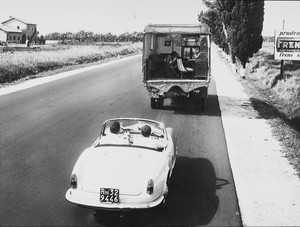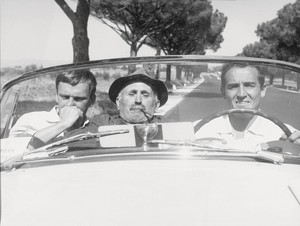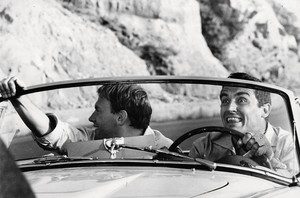
Concepts in Motion
Alison Castle reports on concept cars created by visionaries—architects, artists, amateurs—from outside the field on automotive design.
Spring 2023 Issue
Carlos Valladares writes on Dino Risi’s Il Sorpasso (1962), examining the narrative structure and underlying tensions that keep viewers returning to this classic film.

Still from Il Sorpasso (1962), directed by Dino Risi. Photo: Fair Film/Album/Alamy Stock Photo
Still from Il Sorpasso (1962), directed by Dino Risi. Photo: Fair Film/Album/Alamy Stock Photo
What makes Dino Risi’s 1962 Italian road comedy Il Sorpasso such a lean, dexterous, lovely, and ultimately sad work? It’s not quite the heresy it may sound like to the Sorpasso fan (and I’d consider myself one) to say that the film is low on big laughs. Compared to the extended gags and guffaw-inducing situations that pile up in Pietro Germi’s Divorce Italian Style (1961) and Seduced and Abandoned (1964), or in Mario Monicelli’s Big Deal on Madonna Street (1958), the comedy in Il Sorpasso is played at a far more muted level. I find it helps to approach the film more in the vein of a Jacques Tati comedy: don’t expect outsized reactions. If they come, they come. Stay for the steady, clockwork development of character and see what happens to your body when, having gone along with a plot for as long as it can be pushed, you find yourself wondering, Well, what next? And then everything crashes down, one of the greatest 180-degree twists in cinema history unfolds, and you’re beside yourself in sudden emotion, a total shift in perspective in what you only took for a charming road jaunt.
An impulsive, swaggering drifter, Bruno (Vittorio Gassman), convinces a meek, shy law student, Roberto (Jean-Louis Trintignant), to leave his books behind and set out, the two of them, on a spontaneous road trip across Italy. Most of the film involves the gradual melting of Roberto’s defenses as he comes to embrace what Bruno (for better and especially for worse) represents: “the easy life”—obligations later, live now.
It is a 105-minute film. For 104 minutes it feels like a meandering short story. Then the final minute happens and everything brutally snaps into place. It’s strange how a movie can take on such crisp shape with such a seemingly arbitrary finale, which yet, on reflection, makes the entire venture make perfect sense: Obviously this is the only logical way out. This is what happens when you play with fire, when you live life nihilistically and without aim, just go go go. Everything must stop eventually. It’s physics.

Still from Il Sorpasso (1962), directed by Dino Risi. Photo: Fair Film/Album/Alamy Stock Photo

Still from Il Sorpasso (1962), directed by Dino Risi. Photo: Fair Film/Album/Alamy Stock Photo
Bruno acts as the most incorrigible Don Juan to pretty women while saving his strutting alpha-male bit for threatened men who are just as cocksure as he is but lack his particular fluidity-of-gesture or solidity-of-build. Meanwhile Roberto’s just along for the ride, observing Bruno overtake cars with obnoxious flourish in his Lancia Aurelia convertible while honking madly on its unforgettable Woody Woodpecker–like horn. Roberto sees that people take to Bruno with a swiftness that he, a lowly grad student, envies. After all, isn’t there something wickedly admirable in a man who, to avoid getting a parking ticket for his obviously illegally parked car (which he can easily move), takes the parking ticket off another car illegally parked nearby and puts it on his? It’s the audacity of the action, the brazenness, the seductive effrontery to basic moral codes. But Bruno’s illusion unravels: turns out he’s not a thirty-something swinger but a middle-aged near-has-been who’s been married, and glumly, since he was twenty to a quick teenage fling (Luciana Angiolillo) whom he impregnated. This resulted in a daughter (Catherine Spaak) who, now eighteen, is romancing a middle-aged tycoon despised by Bruno for class and age-gap reasons.
Gassman’s vibrant performance as Bruno was stamped into the Italian consciousness, and “sorpasso” (which literally translates as “surpassing,” i.e., what hot-headed Bruno keeps doing to cars painfully slower than his on the road) quickly became the standard term for a certain brand of Italian man: quick-tempered, bon vivant, with fatal whiffs of the pathetic and adolescent hidden beneath a busy exterior. But the path to becoming a cultural milestone was far from set when the movie first opened. Gassman was box-office poison at the time, having just starred in Roberto Rossellini’s notorious flop Anima nera (Black soul, 1962). That movie had been such a fiasco that, according to screenwriter Ettore Scola in an interview with the Criterion Collection, moviegoers initially avoided the main Roman theater where Il Sorpasso was playing in December 1962, reacting with disgust when they saw the cinema still had Anima nera posters up with Gassman’s face plastered all over them. But the word of mouth quickly spread: this was a new beast of commedia all’italiana. Within a week, Scola says, the cinema was packed with people in hysterics at the antics of the wily Gassman. Perhaps the guys identified with the blustery oaf that Gassman represented, and the girls recognized his type, or plain desired it in that clandestine movie house manner. Gassman’s Bruno is a broad-chested man’s man with insider knowledge on how to game the system of life. He’s the kind of character who would be mercilessly satirized and mocked three years later in Richard Lester’s anarchic, brilliant, complicated film The Knack . . . and How to Get It, based on a play by the English playwright Ann Jellicoe. But there’s a specificity to Italy’s codes of masculinity. Bruno’s own life is a mess, naturally, but he doesn’t talk about that. He doesn’t have time to slow down, to reflect. That’s not something a real man does, with the fast car and the big balls. No sir. Not Our Guy. His armor must remain intact.

Still from Il Sorpasso (1962), directed by Dino Risi. Photo: Picture Lux/The Hollywood Archive/Alamy Stock Photo
That is, until he finally connects with his estranged daughter. Or, until he finally forges a genuine platonic connection with another man by whom he does not feel threatened, a young man whom Bruno successfully pushes outside his meek shell and teaches to appreciate life’s rush. Until he finally forges a feeling that, for the first time in his life, may be love.
Maybe, it seems, he is maturing.
Then, continuing to play his dumb little road games in the last minutes of the movie, Bruno recklessly crashes his car off a rocky cliffside, killing Roberto, while he himself survives with a small cut on his face.
Who was the dead man?
Poor Roberto. He was played by the great Trintignant, who specialized in these weak-willed, shaky-limbed, yet secretly perverse boys, as any glance at his performances in Éric Rohmer’s My Night at Maud’s (1969) or Bernardo Bertolucci’s The Conformist (1970) will attest. He’s another kind of man: shy, romantic to a nauseating degree, afraid of saying something out of line. The love of his life is a neighbor named Valeria who lives across the street from him, but with whom he has never had a single conversation. He barely knows what she looks like; the locket photo he keeps in his wallet is blurry, taken of her in her apartment from a creepy Rear Window–y distance. It takes Bruno to shake Trintignant up and make him take some kind of action. And so he does. The joke: once he does call Valeria, she’s nowhere near the phone that she’s always hovering near; she’s at the beach, and can’t pick up. That’s okay, says Roberto to himself. He’ll just try once he’s back in Rome.

Still from Il Sorpasso (1962), directed by Dino Risi. Photo: Mondadori Portfolio/Bridgeman Images

Still from Il Sorpasso (1962), directed by Dino Risi. Photo: Fair Film/Album/Alamy Stock Photo
And now, that ending. Having Bruno be the one killed would make too much perfect neat sense. It would be unforgivably puritanical. Moral punishment would be meted out to the hell-raiser, and his meek buddy would think twice before calling that girl on the phone. And if both of them were killed . . . well, there’d be delicious irony, but that would fall on the side of the patly nihilistic. It would be too down. But having the hell-raiser survive? While his barely nascent charge goes fatally careening off the side of a cliff, stuck in the passenger seat? Now that’s cinema, which is to say: edging life. One life had ended just moments before: a life of safety, collusion, and conformity, a life that pledged faith to the institution of postwar Italian neocapitalism ushered in by the famous Italian “boom.” That was Roberto before the phone call, Roberto before Bruno. And another life had just been born: one of hard-won freedom, a life of damn-what-society-says, a life led purely by instinct and personal pleasure. But in that crash, all comes crashing down on Bruno, the seemingly chill, seemingly masterful teacher. Life is chancy. Life is savage. Life does not care if you’re planning to call your sweetie tomorrow. If you gamble, them’s the risks. That’s the nature of chance. Fuck around, find out, and don’t be surprised if the dice don’t come out in your favor—maybe next time, with a new Roberto, they will.
It’s a perfect tag to the story. It’s the only tag possible.
And now I’d like to know: while these two-days-that-feel-like-a-week were unfolding, what was Valeria doing? What’s Valeria’s story? What was Valeria’s week of wonders?
Marc Newson’s supplement also includes: “In Conversation: Ruth Rogers and Marc Newson”, “Concepts in Motion” by Alison Castle, “Iwa Sake and Kura”, and “Sketch Book” by Marc Newson.

Carlos Valladares is a writer, critic, programmer, journalist, and video essayist from South Central Los Angeles, California. He studied film at Stanford University and began his PhD in History of Art and Film & Media Studies at Yale University in fall 2019. He has written for the San Francisco Chronicle, Film Comment, and the Criterion Collection. Photo: Jerry Schatzberg

Alison Castle reports on concept cars created by visionaries—architects, artists, amateurs—from outside the field on automotive design.

Marc Newson joins restaurateur Ruth Rogers to discuss the compendium of topics he selected for a special supplement he guest-edited for the Spring 2023 issue of the Quarterly.

As part of the artist’s guest-edited special section for the Spring 2023 issue of the Quarterly, Marc Newson reflects with IWA Sake founder Richard Geoffroy and architect Kengo Kuma on their respective contributions to IWA Sake in Japan: bottle, brewing, and building. The sake brewery, or kura in Japanese, takes its name from its site of Shiraiwa, located in the town of Tateyama.

The Tokyo Toilet project has added twelve new public restrooms by renowned architects and designers to the city’s map since 2020, with five more scheduled to open in 2022. To learn more about the initiative, the Quarterly spoke with founder Koji Yanai and two of the participating designers, Toyo Ito and Marc Newson.

Marc Newson tells Derek Blasberg about his newest creations, explaining the backstory of these ornate works.
In this video, Marc Newson provides an overview of his latest exhibition. He details the various technical processes behind his new designs, including works in cloisonné, surfboards, swords, and large-scale glass chairs.

The Spring 2019 issue of Gagosian Quarterly is now available, featuring Red Pot with Lute Player #2 by Jonas Wood on its cover.

David Cronenberg’s film The Shrouds made its debut at the 77th edition of the Cannes Film Festival in France. Film writer Miriam Bale reports on the motifs and questions that make up this latest addition to the auteur’s singular body of work.

The mind behind some of the most legendary pop stars of the 1980s and ’90s, including Grace Jones, Pet Shop Boys, Frankie Goes to Hollywood, Yes, and the Buggles, produced one of the music industry’s most unexpected and enjoyable recent memoirs: Trevor Horn: Adventures in Modern Recording. From ABC to ZTT. Young Kim reports on the elements that make the book, and Horn’s life, such a treasure to engage with.

Louise Gray on the life and work of Éliane Radigue, pioneering electronic musician, composer, and initiator of the monumental OCCAM series.

Tracing the history of white noise, from the 1970s to the present day, from the synthesized origins of Chicago house to the AI-powered software of the future.

Ariana Reines caught a plane to Barcelona earlier this year to see A Sea of Music 1492–1880, a concert conducted by the Spanish viola da gambist Jordi Savall. Here, she meditates on the power of this musical pilgrimage and the humanity of Savall’s work in the dissemination of early music.